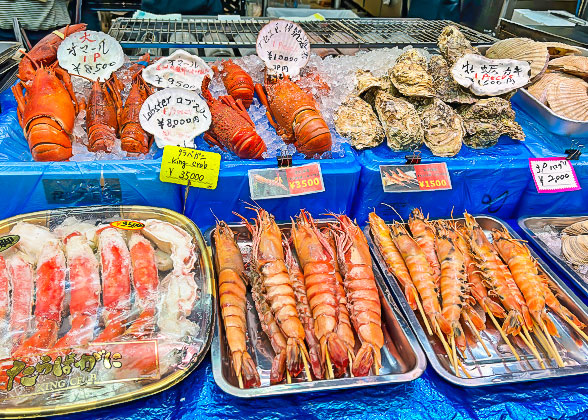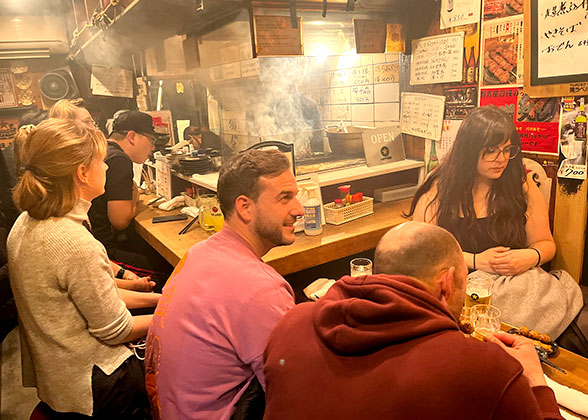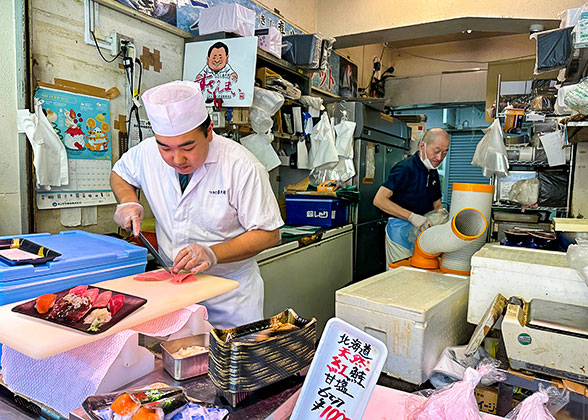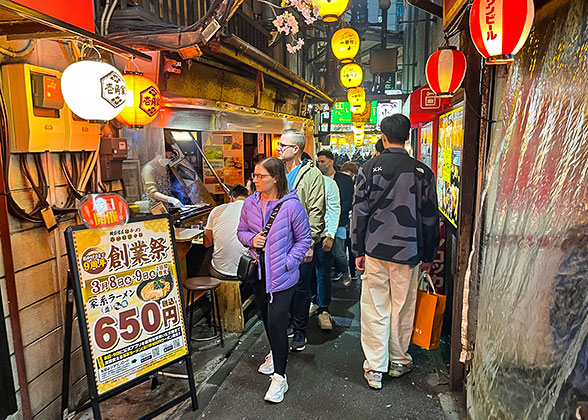Japanese Food – Healthiest In the World
Japanese cuisine, the light food of Japan, requires natural ingredients, bright colors, diverse utensils, etc., which is to create a feast for the eyes, not just for the gustation. Japanese pay a special attention to seasonal changes, as they would adapt to different ingredients, seasonings, and cooking methods in each season. For the diverse fresh ingredients and balanced diet, Japanese food has been praised as an intangible world cultural heritage.Features of Japanese Food
Natural Seasonal Ingredients Are Selected
Japanese cuisine focuses on the food itself. They prefer to select natural ingredients and present the original food to guests. Regardless of fishes, meats, and vegetables, Japanese cooks bend themselves to keep the original flavor of these ingredients. Meanwhile, the abundant local ingredients in season are usually utilized as Japanese always adopt to the circumstances.

Fresh Seafood in A Local Market
|
Delicate Dishes and Soup with Staple Food Rice
Rice is the staple food for Japanese, also the essential part of a meal in Japan. For all the food not just rice, they would not fill too much into the bowl, making it look little but fine. Usually, a cooked fish or fish segment is put over the rice. A simple Japanese meal just include a small bowl of rice with fish, a small bowl of soup, and a small piece of side dish like local pickles and boiled, deep-fried, or steamed vegetables. Miso soup is their favorite soup, while it could be even simpler to remove the side dish, especially for the breakfast.Simple Cooking Methods & Considerable Seasonings
The cooking methods of Japanese cuisine is relatively simple, including cutting, boiling, grilling, steaming, and deep-frying. Comparatively, there are a wide variety of seasonings to enhance the flavor of food. Special light dipping sauce, sugar, vinegar, miso, mustard, wasabi, soy sauce, lemon juice, oranges, etc. are often used. Mushrooms, seaweeds, pickles, fish soup, and more are also applied to freshen the food.Perfect Combination of 5 Colors and 5 Tastes

|
Particularly for a formal traditional Japanese meal, it’s required to include all the cooking methods or techniques, 5 colors (red, yellow, blue, white, black), and 5 tastes (sour, sweet, bitter, spicy, salty). Apart from the display on the table, all elements are utilized to make the meal good-looking. Except for Japanese aesthetics, such requirements guarantee the reasonable nutrition arrangement as well as a healthy diet.
Classifications of Japanese Dishes
Japanese dishes are mainly divided into three types: washoku, yōshoku, and chuka.Washoku: Traditional Japanese Food
Washoku refers to the most traditional Japanese food that was created in Japan. These are the Japanese inventions totally, such as sushi, takoyaki, miso, most seafood, and those made from kelp or other seaweeds in the country.Yōshoku: Revised Western Food in Japan
Yōshoku is also a significant part of Japanese cuisine. Curry from India, omelette from France (omurice in Japan), pasta from Italy, etc. were all improved to fit the Japanese flavor, ingredients, and circumstances. Although these dishes didn’t origin in Japan, they has developed into special Japanese food and been well-known as the dishes of the oriental country.Chuka: Transformed Japanese Chinese Dishes
Japan also has many food introduced from China. The same as yōshoku, chuka has been changed and formed a unique taste of Japan’s own. For example, gyoza, the Japanese pan-fried dumplings, is the typical chuka food popular with local people and tourists.
|
|
|
Sake – Japanese Wine
Sake, the Japanese wine in a sweetish, spicy, or sour flavor, is also a crucial part of Japanese food. It’s the favorite drink of Japanese, as a type of table wine or after-dinner wine, so you can see sake on Japanese’s dining table anywhere. Furthermore, many Japanese food is very suitable to go with sake. Sake is usually stored in dark place, enjoyed at the room temperature or heated in winter. The drinking vessel is a small shallow bowl or small ceramic cup, which is very Japanese and is the same set as the tableware.Sometimes, the local people pour some sake into their soup at a proper ratio, the sake soup is also common in izakayas with an umami taste. Otherwise, they also add fresh egg liquid and sugar or honey into the heated sake. It’s said that, this is effective when someone having a cold. You could try it on your Japan journey.
Distinctive Styles of Japan Food
Honzen Ryōri (本膳料理)
Honzen Ryōri/Cuisine is the local cuisine based on traditional culture and habits of Japan, arisen in the Muromachi Period (1336-1573 AD). Honzen Ryōri can only be found at some formal occasions now, such as weddings, funerals, coming-of-age ceremonies, and local festival banquets. Five dishes and two soups or seven dishes and three soups are served at most of time, while these dishes are also made into auspicious shapes.Kaiseki Ryōri (懐石料理)

A Simple Japanese Meal
|
Legend goes that Zen monks in their spiritual practice were required to have breakfast and lunch merely during a day. As nothing to eat in the afternoon, the young monks who could not bear the hunger wrapped a heated stone in a cloth and carried it in their arms to warm the stomach, so as to withstand the hungry hours. The word “Kaiseki” just meant embracing the stone in the arms, later it gradually developed into the synonym of eating less to play the role of "warmed stone" against hunger. Also, it has been utilized to name the form of Japanese cuisine.
In addition, Japanese create more styles of food for different occasions and festivals. Another Kaiseki Ryōri (会席料理, the same pronunciation but different writing) is a more homely style for colorful social activities. It was originally enjoyed with Japanese sake, so the dishes are often those go with the local alcohol. The food is served dish by dish, sake and dishes are usually served first, followed by rice and soup.
Shojin ryōri (精進料理) is the simple vegetarian Japanese food for those who are striving for virtue and Buddhist essences. Beans, tofu, miso, grains, vegetables, kelps, etc. are cooked, without fishes and meat. Besides, Osechi ryōri (御节料理) is the special food style for New Year. On more festivals like Jinjitsu (January 7th), Jyoushi (March 3rd) and Tanabata (July 7th), Japanese would enjoy their osechi ryōri as well. The dishes of osechi ryōri are prepared in advance, and they won’t fire up and cook on the day of the festival.
Read More:





